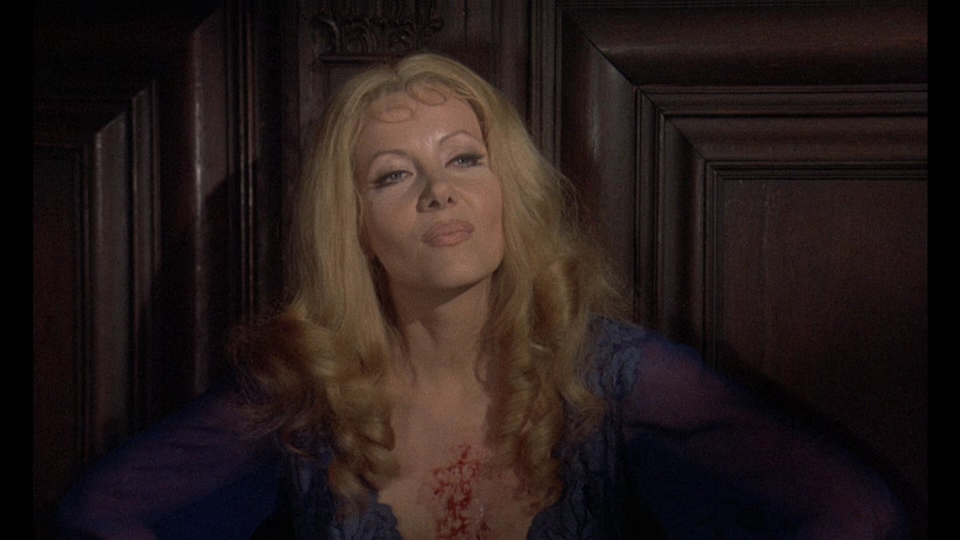Countess Dracula

This Hammer production isn’t a vampire story but a take on the Elizabeth Báthory legend, starring Ingrid Pitt as the Countess.
Báthory was a real-life Hungarian Countess who allegedly tortured and murdered dozens of women to bathe in their blood, believing it preserved her youth. Pitt’s character is even named Nádasdy, the name of Báthory’s husband.
The film opens with Pitt as a wrinkled widow still adored by her lover, the castle steward, played by Nigel Green. After a servant girl’s blood splashes on her cheek, Pitt discovers the cheek’s wrinkles gone. A quick murder later and Pitt’s restored to youth, parading for Green and the audience in a barely there blue robe. Posing as her own daughter, Pitt then sets her sights on a young soldier, played by Sandor Elès, only to discover the blood’s effects require increasingly frequent applications, leading to more murders.
Director Peter Sasdy had directed Hammer’s Taste the Blood of Dracula a year earlier, but his other credits were all in television. Producer Alexander Paal was a Hammer newbie, as was writer Jeremy Paul, who also came from television. The cast, aside from Pitt, doesn’t feature any of the Hammer stock company like Michael Ripper, André Morell, or Francis Matthews. It didn’t even shoot at Bray Studios.
The film also transplants the action from Hammer’s usual fictitious Western European locales to seventeenth-century Hungary. With Hungarian natives Sasdy and Paal at the helm, the production embraces regional touches, such as Russian and Mongolian influences in the costumes.
Thus, despite the castles, blood, and ample cleavage, the film doesn’t feel like a typical Hammer horror. Instead, similar to Hammer’s Rasputin: The Mad Monk, it seems torn between historical melodrama and horror.
The supernatural elements are downplayed. No one questions why the blood restores Pitt’s youth. It’s accepted matter-of-fact, like a beauty treatment rather than something unholy. Most of the girls Pitt murders are introduced only moments before their demise, and their deaths are quick. There’s a subplot involving Pitt’s real kidnapped daughter, but her captor seems intent on winning her over instead of terrorizing her. Though it features ample skin—including a memorable shot of a nude Pitt sponging herself with blood—it offers few scares.
Rather than horror exploitation, the film serves up a doomed romance between Pitt and Elès, with her murderous secret serving more as a melodramatic obstacle than supernatural terror. Paul’s script elevates this element with some great dialogue. Consider the tavern sequence where a drunken Elès urges Green to marry the Countess. Green, sober, replies, “Why should a man be a slave to one woman when he can have the pick of any?”
“Oh but if that woman embodies all the virtues?” asks Elès.
“Mistress, friend, and mother in one? Does such a woman exist?” says Green with a smile.
“You know she does!” says Elès. “And I have found her.”
The “mistress, friend, and mother” line proves telling, as Green is—albeit inadvertently—describing the Countess’s relationship with Elès, as she’s carrying on an affair with him (mistress), offers to serve as his guide through the nobility (friend), and refers to him as “son” in her aged form, and then again later when she’s young (mother).
Unfortunately, this double entendre proves wasted as Elès and Pitt have no chemistry. With his fake mustache and slender build, he looks foppish, hardly who you’d expect Pitt’s ruthless and lusty character to pursue. Compare him with Green, who towers over the relatively diminutive Elès, sports a real beard, and exudes far more relatable chemistry with Pitt. This misstep cripples the film, as we’re at a loss to understand what Pitt sees in him, and thus have trouble investing in the romance.
Pitt herself seemed to sense the film’s lack of edge, pushing for moments to offset the tepid romance. Robert Michael Cotter quotes her in Ingrid Pitt, Queen of Horror, as saying, “For instance, the scene where the barmaid is murdered and there’s no blood. I said to [director Sasdy], ‘Please, hang the girl up by her feet, cut her open, and let the blood flow down from her body and let the Countess wash the blood all over herself… let her bathe in the girl’s blood!’”
In her autobiography Life’s a Scream, Pitt further recalls Sasdy and Paal having frequent arguments on set. They fought in their native Hungarian, so the issues were unclear, but these fights led to a tense atmosphere that further undermined the production.
Topping it all off, Sasdy dubbed Pitt’s voice without her knowledge after she’d wrapped filming. According to Pitt, Sasdy said her performance “Wasn’t the Queen’s English.” When she pointed out that the character wasn’t English, Sasdy retorted, “If you play a Royal, you speak like a Royal.”
They might have done better to dub Elès, something Pitt raised, but Sasdy dismissed it, saying, “Oh it doesn’t matter how he sounds. It’s the Countess who matters.”
These issues make Countess Dracula difficult to recommend. Some Hammer fans may appreciate the change of scenery and formula, while others may chafe at those same diversions. Some Pitt fans may appreciate her dual leading role, while others may chafe at her dubbed voice. I found the film more interesting as a curio than entertaining. If you’re curious, make sure you’ve exhausted the studio’s better efforts before giving it a watch.